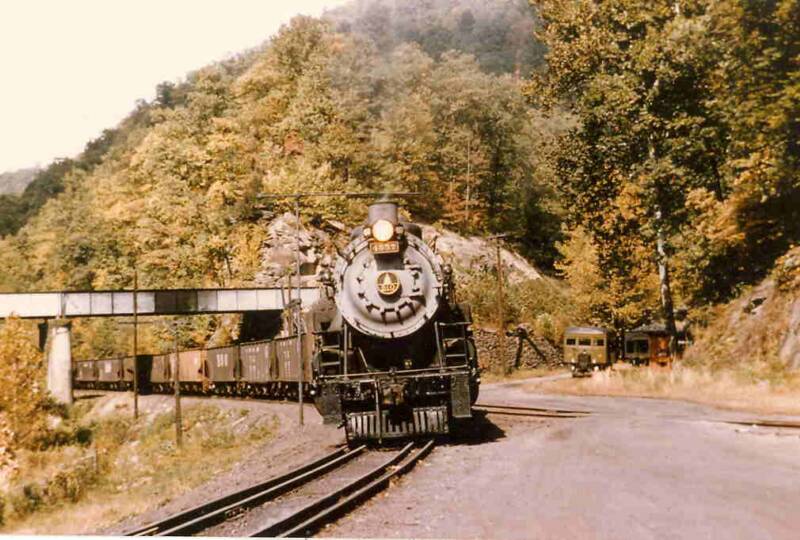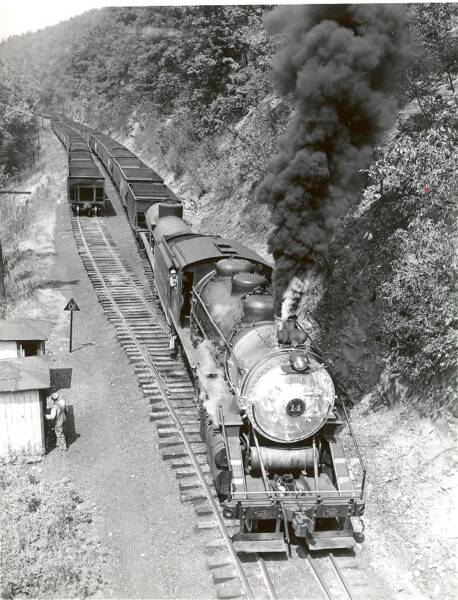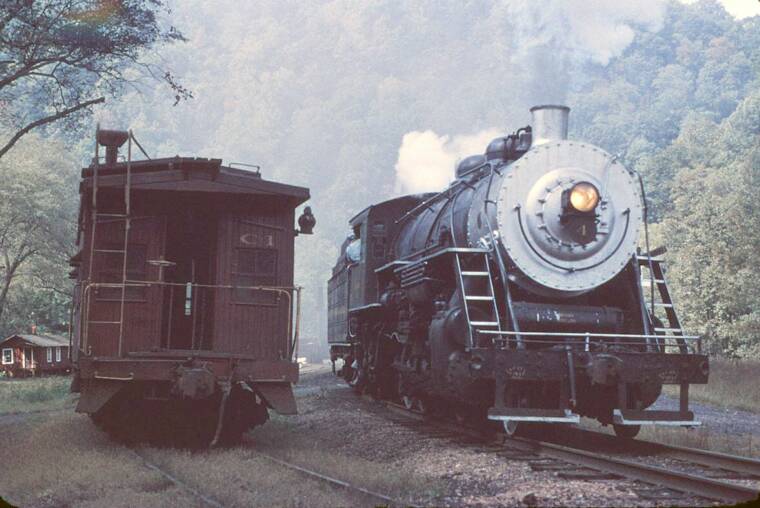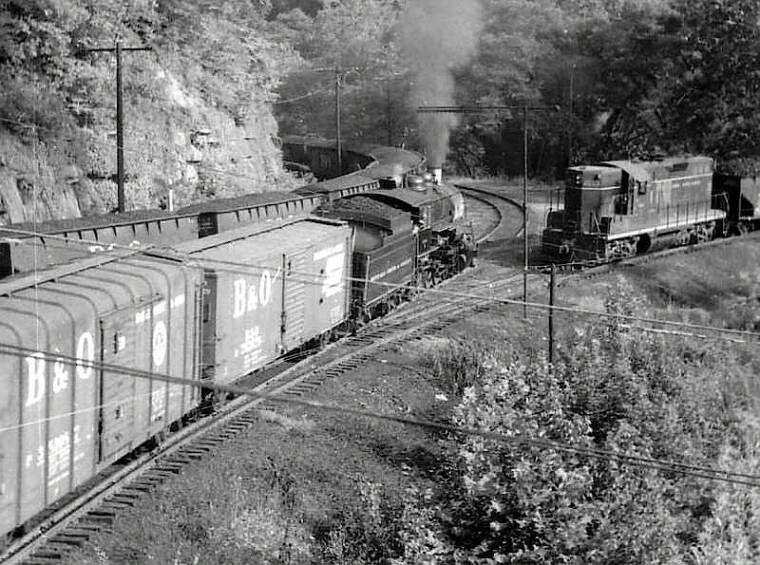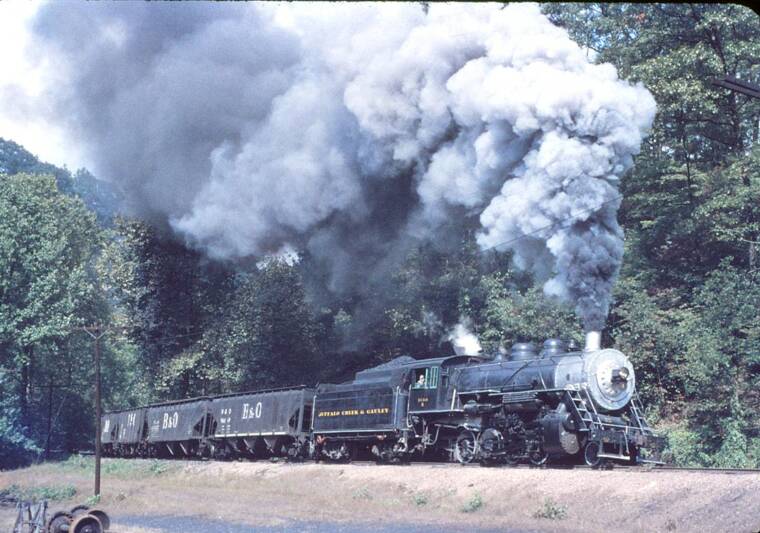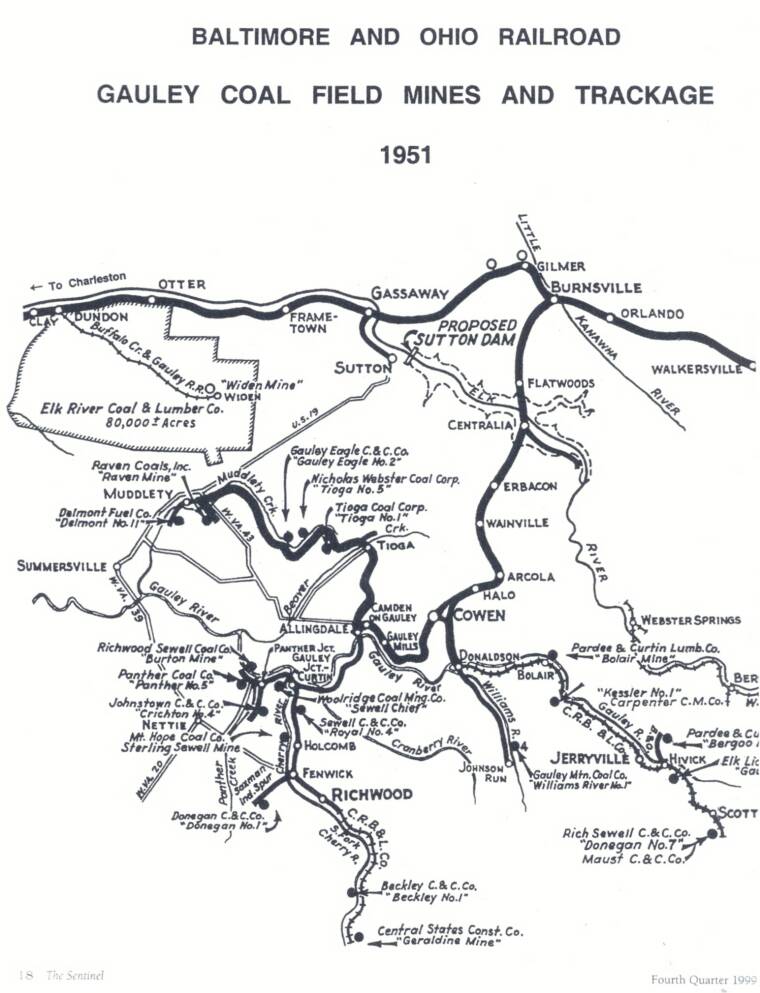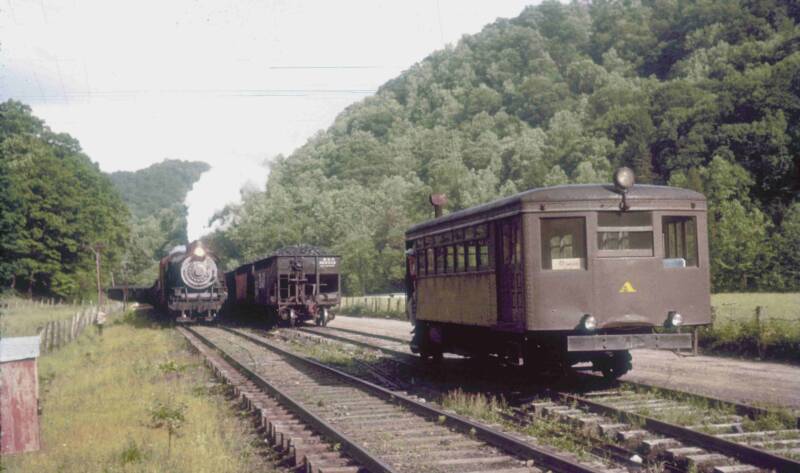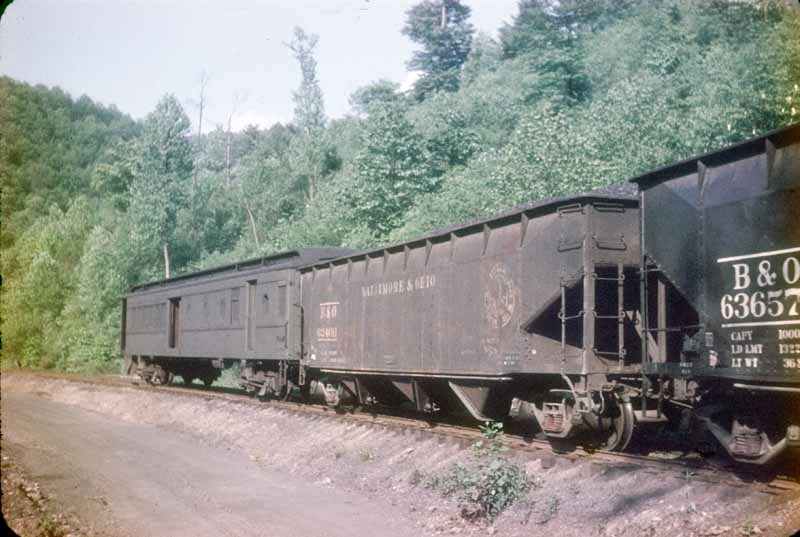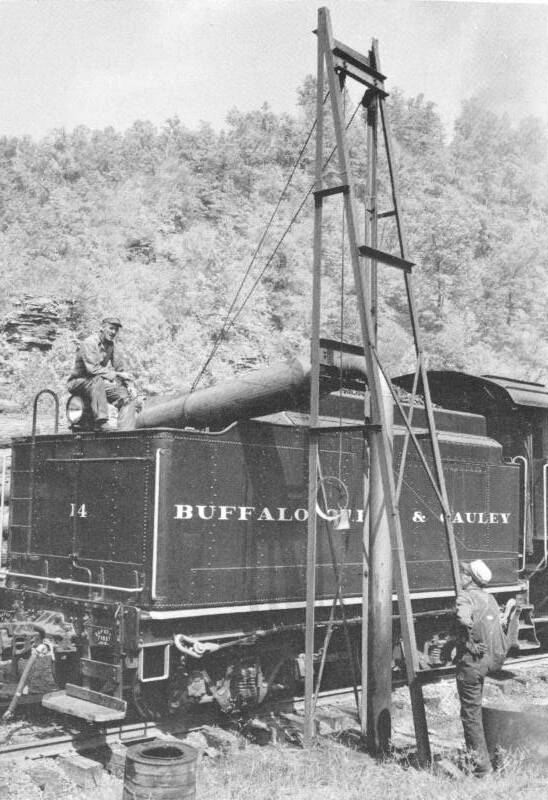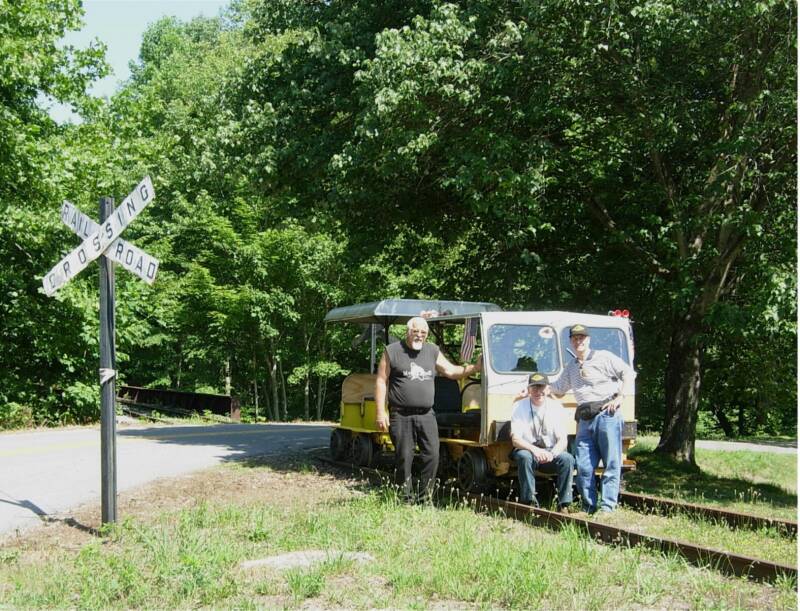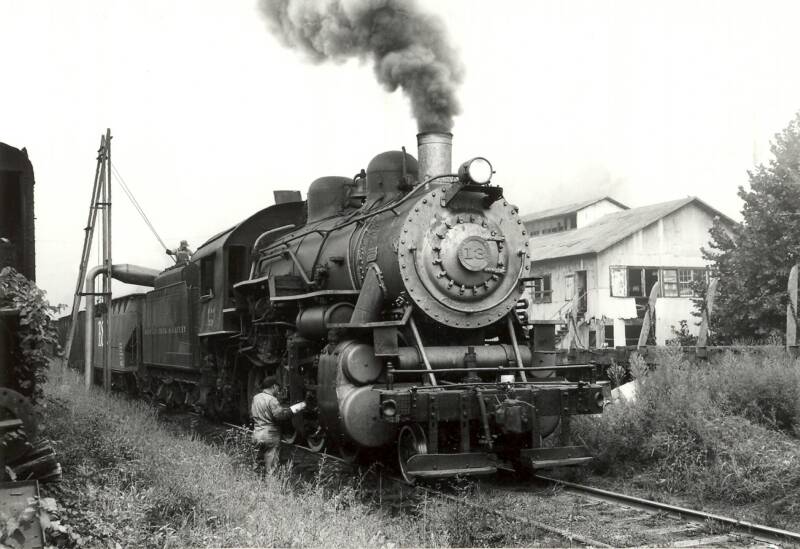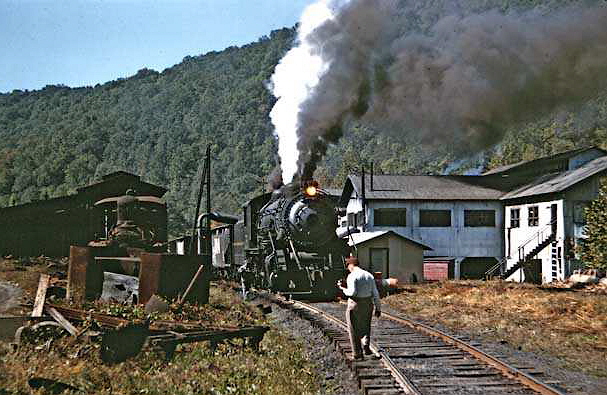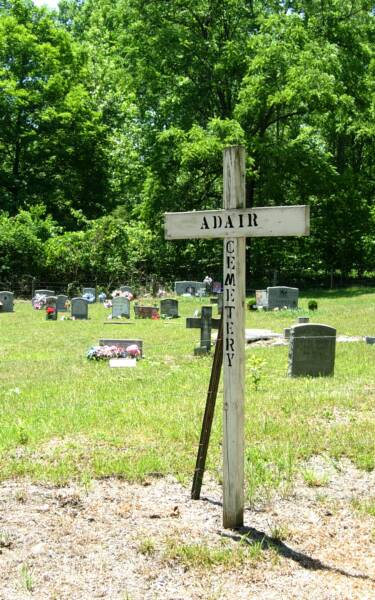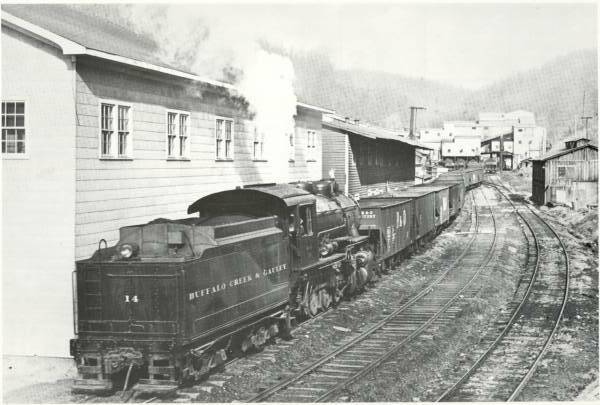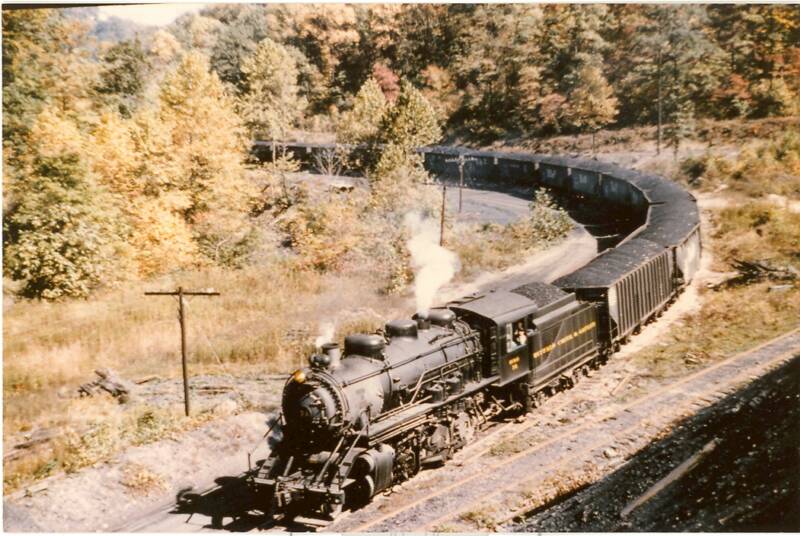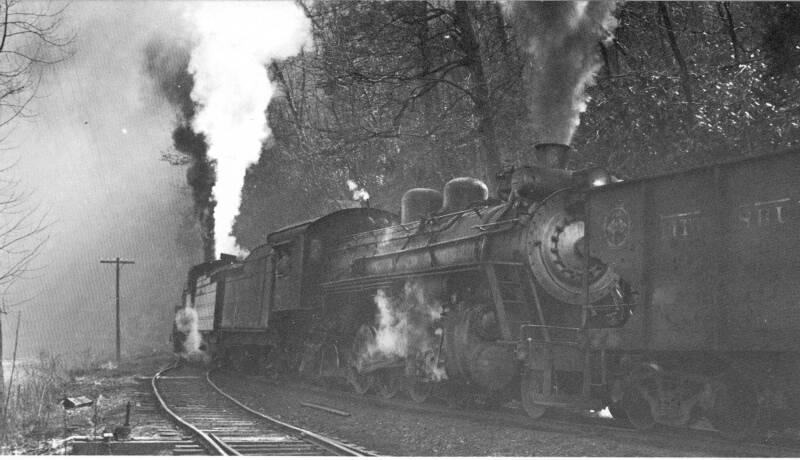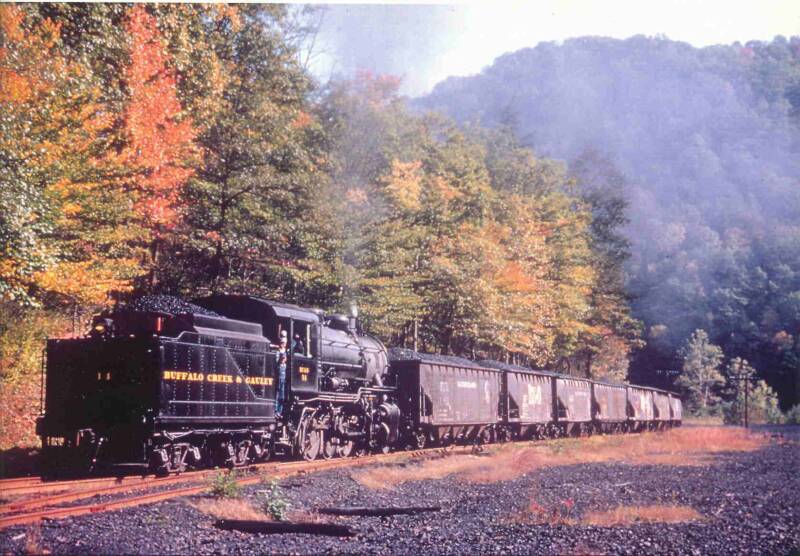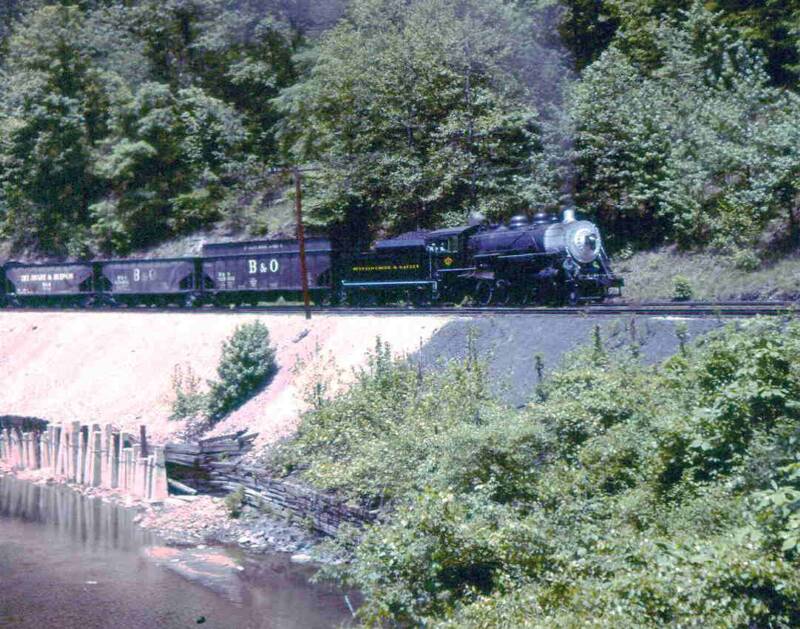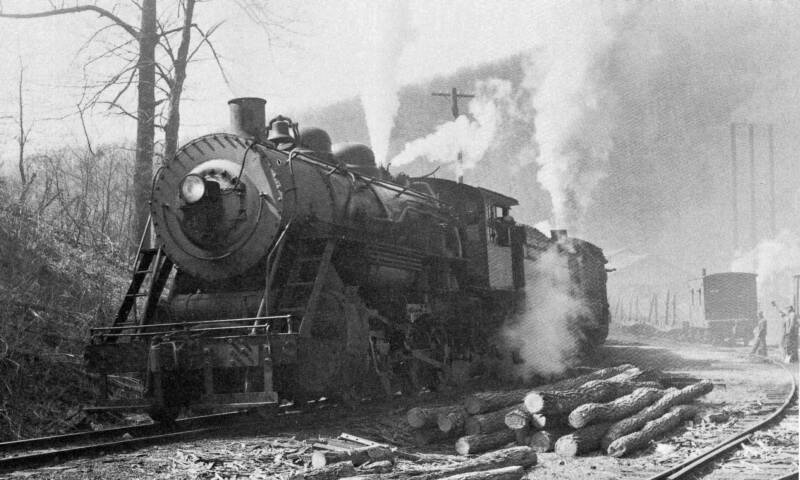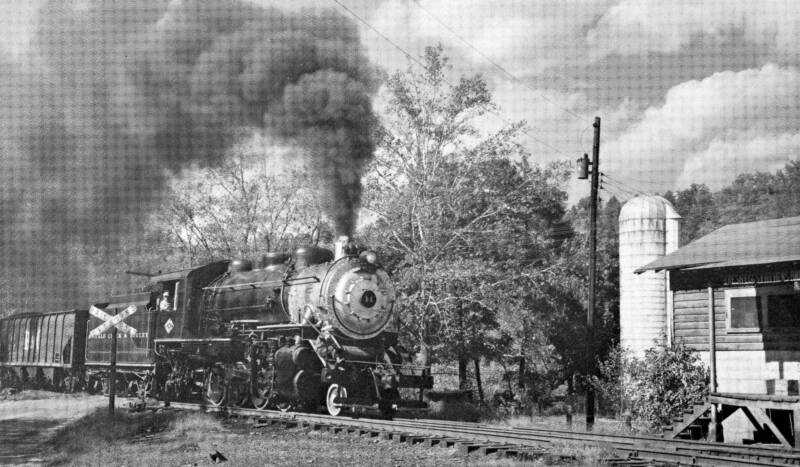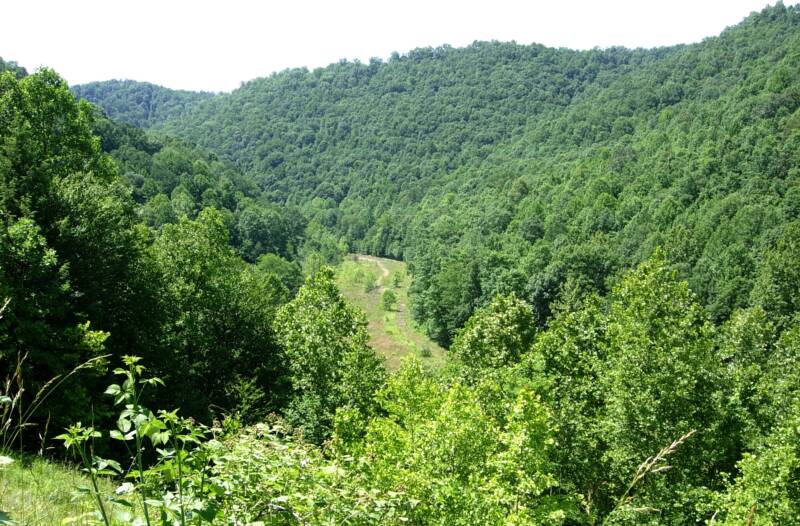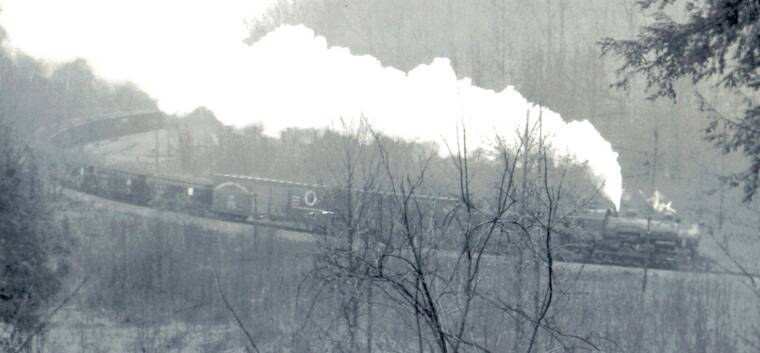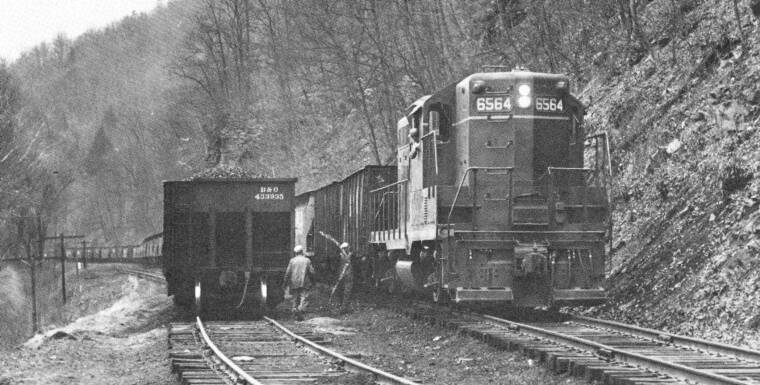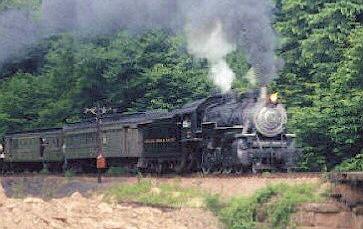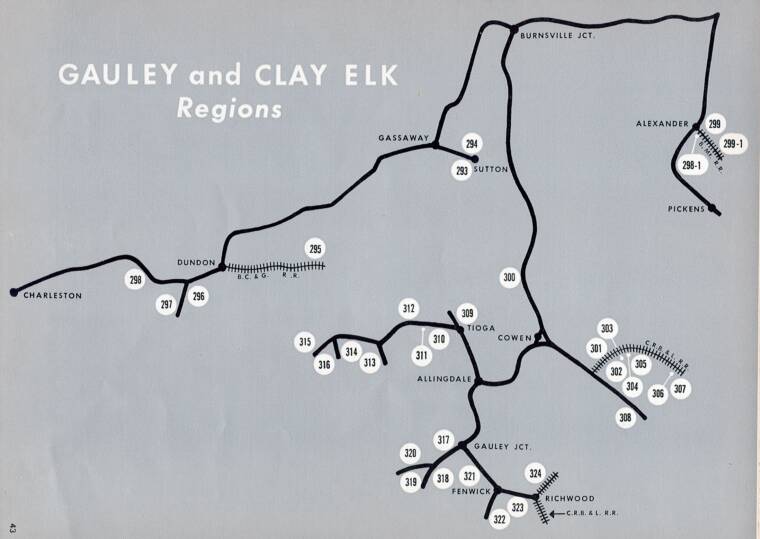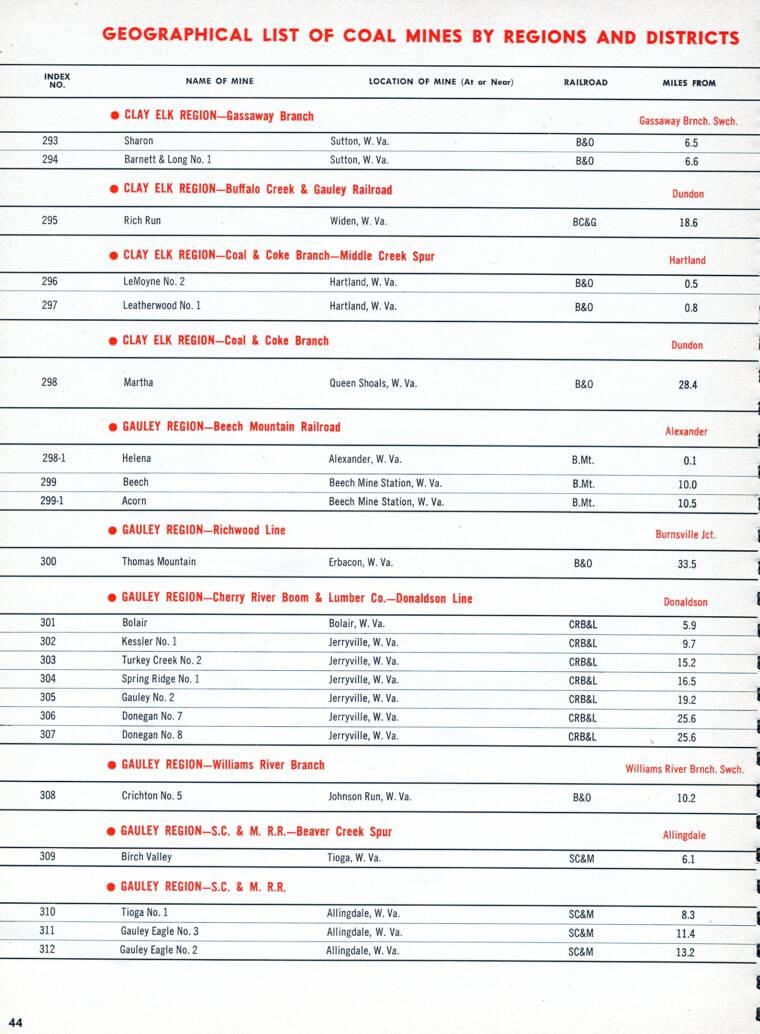Freight Operations
From an operational standpoint, the BC&G was not very complex. It had only one interchange. It served only four significant communities. It had just one main customer, the Rich Run Mine at Widen. It had a single track mainline just 18.6 miles long and it had no signaling system. For most of it's life it ran only one kind of train, mixed trains. At first glance it might be overlooked by operations oriented modelers for these reasons. But the ERC&L logging trains shared the BC&G track between Avoca and Swandale and the Mack Railbus, known as Motor 'A', made a couple of trips a day so alot of action was packed into this little railroad.
The day started around 10:00 when, after servicing the day's engine with sand in the Dundon shops, and coupling on to the 'caboose' (see sidebar on Cabooses this page), the engine would pull out on the main and back about a mile to the B&O interchange (see Dundon diagram). According to Richard Manning, a crew consisted of an engineer, conductor, fireman and two brakement.
There is some question as to whether the caboose was left on the yard lead (see insert 10-61 photo by Doug Wingfield) and picked up after the hoppers were pulled off the main or if it was taken to the interchange.
The interchange consisted of two very long sidings nestled along the Elk River just beyond the Dundon station as seen in the photo to the right. Here the crew would pick up 60 to 80 empty hoppers destined for the mine at Widen and possibly a box car or two of supplies for the sawmill, mine or company store. Photos also show an occassional tank car in the consist.
It was the B&O Grafton Local that served the interchange. It operated on the 187 mile B&O line between Grafton and Charleston. It dropped off and picked up hoppers for mines all along its route. In the wonderful color photo by Bill Price below, a B&O Q4 #4557 is handling the interchange duties. Some photos show the BC&G engine at the interchange at the same time as the B&O engine. In more recent years the B&O engine was one, and sometimes a pair, of GP9's (photo below right).
ENGINE ROTATION
According to a letter from Richard Manning, during the 50's when there were 3 engines in service, the rotation of the engines went like this: Each engine was in service for a month. A second engine was ready to go and held as a backup. The third engine would be out of service undergoing maintenance.
TRAIN SCHEDULE effective June 1920
Richard Manning collection
Bill Price photo - 1954
WEST BOUND EASTBOUND
Lv -Widen 6:00 am Lv - Dundon 8:30 am
Lv Swandale 6:35 am Lv- Cressmont 9:10 am
Lv Cressmont 6:45 am Lv - Swandale 9:20 am
Ar Dundon 7:25 am Ar - Widen 10:00 am
Lv - Widen 1:00 pm Lv - Dundon 4:45 pm
Lv - Swandale 1:40 pm Lv - Cressmont 5:25 pm
Lv - Cressmont 1:50 pm Lv - Swandale 5:35 pm
Ar - Dundon 2:40 pm Ar - Widen 6:25 pm
The exact schedule of operations varied over the years. One illustrative schedule from 1920, found by Frank Criswell in a 1920 FInancial Statement, shows a typical two-trains-per-day schedule. It is interesting because it shows the arrival and departure times for the stops at Swandale and Cressmont as well as Dundon and Widen. For schedules for 1915, 1929, 1939 and 1950, see the Passenger Operations page.
From the 1950 schedule it can be seen that two trains were still scheduled each day except Sunday. While I have no published schedules to confirm it, my underestanding is that by the late 1950's and early 1960's the schedule was reduced to just one train per day operating 5 days per week.
B&O Interchange at Dundon
The photographer is unknown but the Dundon store is gone so this photo was probably taken in the mid-1960s.
DIVISIONS
According to Roger Nutter, President of the BC&G Co-Op, and former employee of the line, the 18.6 miles was divided into four "divisions" and there was a division or section foreman and crew assigned to each. Every day before the coal train made it's run, each of the crews visually inspected every mile of the railroad for fallen rocks, trees or other track damage. With the right-of-way being in such rugged country, the need for this is understandable.
It is believed that all BC&G trains ran as Extras. According to the NRHS Bulletin 3rd Qtr 1955, "dispatching was done verbally by telephone from Dundon where Mr. R.C. Johnson was dispatcher, billing clerk, agent and coal traffic manager. Written orders were issued at Widen, Swandale or Dundon whenever necessary".
Roger Nutter indicated that there were phone boxes on telephone poles at various places along the line and that crews carried handsets that they could connect to one of the boxes to contact the dispatcher if needed.
Halfway to Widen was Swandale and the big sawmill. A 10 minute stop was made at Swandale for water and to often set out a box car or empty chip hopper. This is one of those photographs that modelers seach for. Every detail of the BC&G's unique angle-iron waterplug is visible in this photo. Water was fed from a tank on the hillside. Only the concrete pad the plug sat on remains today. This photo has 'shortline' written all over it. It's from pg 59 of the Warden BC&G book and is one of my favorites. This photo was taken just months before the Widen mine closed.
The first significant settlement the train would reach is Cressmont. The coal trains would normally not stop here although there was a passing siding here to facilitate meets. According to Richard Manning the siding capacity was about 12 cars. Cressmont was a scheduled stop during the era of mixed trains, as well as for the Railbus when it regularly carried passengers.
There are also references that loaded hoppers were sometimes stored on the Cressmont siding, a fact confirmed in the Marquis photo below, This photo is looking east with #13 returning from Widen. The dairy is just out of sight to the left. To the right is the dirt road that ran from Cressmont to Swandale. Many pacing shots of trains were taken from this road. This photo perfectly captures the character of the BC&G...long coal trains, neat railbus and beautiful mountains.
There were no settlements to speak of between Swandale and Widen, just beautiful mountain scenery and winding track. At Bone Town Gap (photo, right) just west of Widen the track broke into a wide valley and made a final curve to enter Widen. The roadbed (arrow) is clear in this view from high on the hillside.
No BC&G switcher was assigned to the Rich Run Mine so the road engine and crew switched the mine. From written sources and video recordings, it appears the engine ran around it's train and in two or three cuts pushed the empties under the tipple. The track under the tipple stretched a good distance behind it and was on a grade. Hoppers were moved under the tipple by gravity and once loaded rolled by gravity into at least one makeup track, maybe more.
It is not clear whether the engine waited in Widen while the hoppers were loaded or whether the loaded hoppers were waiting on the makeup track. I doubt the tipple could hold 60 cars of coal and it would take hours to load 60 cars, I would think. I suspect loaded outbound hoppers were waiting.
According to Richard Manning, the BC&G engines were coaled by running them under the tipple. I have never seen a photo of this operation. I have seen photos of a coal hopper and a belt loader in Dundon Yard. It may be that after the mine closed in 1963, the engines were coaled in Dundon.
There are reports that on some days crews spent the night in the caboose at Widen when weather or rockslides closed the track to Dundon.
The return west-bound trip to the interchange was downhill and much easier on the equipment and crew than the east-bound trip. Basically the engine was used as a brake.
As suggested by the 1950 Annual Report, nearly every day a load of lumber was picked up at Swandale on the return trip for delivery to the interchange.
CABOOSES
While the line was chartered in 1904, it's first caboose did not come on line until 1959! Up until then, coaches or combines were coupled to the rear of the train. Up until 1941 these cars carried paying passengers making all the BC&G trains 'mixed trains'. See Passenger Operatons.
At Avoca where the Lilly Fork logging branch headed off into the woods there was a wye. Upon arriving at Avoca on the return trip, the coal train executed a move that's fun to duplicate on a layout. The engine was cut off from the train and turned on the wye. This move got the engine facing the right way for the next day's run. The train then proceeded past the Dundon Yard and to the B&O interchange tender- first and set out the loads on the interchange track. It would then return to the Dundon yard with the caboose and any cars that might be destined for the yard.
In the earlier years there was a wye at the interchange with the B&O main being one leg and the BC&G main forming a second. The third leg intersected the B&O south of Clay at a place apparently called "South Dundon". The date when the third leg was removed is unknown (per inside back cover of Warden's BC&G book).
In another of my favorite photos, below, #14 appears to be rolling tender-first past the entrance to the Dundon yard with a string of loads on a beautiful fall day. The lead to the yard can be seen in the left corner descending a slight grade as it sat well below the mainline.
DOUBLE HEADERS
The subject of double headers and when and how often they were utilized is subject to some conjecture.
This is the only still photo I have ever seen that confirms the use of the ex-Pennsy coaches as cabooses on coal trains.
Cressmont
Swandale
Widen
I believe this photo (left) was taken on the BC&G between the shops and the interchange. The hopper behind the engine is for wood chips from the sawmill. In the summer of 2007, Frank Criswell, George Pierson and myself searched for this location but could not find it for certain. The embankment is now fully overgrown, of course. The detail of the pilings at the foot of the embankment would make an interesting model.
Here #14 is rolling past the dairy eastbound for Widen. Many photos were taken at this location because of its scenic nature and the ease of access. The photo below was taken in the summer of 2007 from almost the identical vantage point, although the motive power was different! The crossbuck even looks to be an original, athough that can't be confirmed. The Cressmont bridge is just across the road to the left in both photos. From left to right in the photo are Roger Nutter, Frank Criswell and Brooks Stover.
Dave Marquis photo - circa 1958
George Pierson photo - June 2007
Dave Marquis photo
Jernstorm collection - circa 1958
Russell Baum photo
There are numerous pictures like the three shown here of locomotives taking water at Swandale. I have seen no photos of cars actually being set out here although that certainly was common as a least one car was dropped here almost daily. In the photo to the right the remains of one of ERC&L Climax #2 can be seen as well as a nice view of the sawmill, in color no less. The steep rise of the hillsides is clear in the photo, too.
Jack Wheelian - September 1963
Adair
With the train made up, the crew would begin the run up the valley to Widen. It is basically up-hill all the way with grades varying along the route. (See Track). The grade wasn't the only challenge, of course, as the track curved continuously all the way to Widen.
The first little community encountered was Adair with it's handful of houses. Today all that remains is the cemetary which is still carefully maintained. I've seen no photos of trains passing through Adair nor the houses there.
Brooks Stover photo - 2007
Brooks Stover photo - 2007
Once the empties were in place the engine was turned on a wye about a mile west of the tipple then returned to the ready tracks and made up the train of loads. Sixty hoppers was the rule in the 1950's and 1960's. In the photo below right, the train is on the main heading back to Dundon with the loads. The second leg of the wye is visible in the foreground. The third leg of the wye is hidden in the brush (arrow) and led to the track on the top of the gob pile.
Richard Manning collection - October 1960
Max S. Robin collection - date unknown
Phil Ronfor - March 1957
Avoca
Al Chione collection - circa 1960
The photo above appears on page 28 of the Warden BC&G book. The caption says that the practice of double-heading was common as was the tender-to-tender coupling with the second engine being an ERC&L gob engine. This is one of only two known photos of double headers, (the second is below) and both were taken on the same day by the same photographer. From the lower photo it is clear that it is a train of empties heading east to Widen.
Richard Manning's recollection in a 1992 letter was that double heading "was not a rare occurence", but his explanation was that gob engines were used to assist a loaded train leaving Widen for the interchange. This doesn't seem too logical, actually, since the westbound trip was downgrade.
In 1993, Bobby Caruthers said that when trains were double headed, the second engine was cut in 5 cars behind the lead engine due to bridge loading considerations. I've found no other reference to this practice.
In the photo to the left from page 64 of the Warden BC&G book, the double header of #4 and 2-8-2 #17 is clearly departing Swandale eastbound for Widen with empties. The two engines are coupled tender-to-tender.
It would be great to have more infomation about double heading on the BC&G!!
Jack Wheelihan - 1963
COAL CONSUMPTION
On a typical round-trip to Widen and return, a BC&G locomotive would burn 8 tons of coal.
Phil Ronfor photo - March, 1957
DISPATCHING
Some additional insight into dispatching operations has been provided by Herald Baughman. Hearld worked in the Dundon office in the mid-1950's.
Baughman says:" "Robert 'Bob' Johnson was the dispatcher for the BC&G. He worked at the Dundon Office. The Motor Car had a regular schedule between Dundon and Widen since it carried passengers as well as mail and cargo. The other traffic consisted of the coal trains, lumber trains, and maintenance vehicles that traveled the track. Telephone boxes were located at each station along the way. Throughout the day, Bob's phone would ring and he would be heard giving instructions as to whether the caller should proceed to the next station or wait where they were until others in route would pass. It was all done by phone."
WIRES DOWN! - by Herald Baughman
Herald recalls this great story about keeping the telephone lines in service as they were the key to safe operation of the railroad:
John Lanham was an old guy with a beard who was in charge of keeping the phone lines operating between Dundon and WIden. On a cold winter night in 1953, a foot of snow fell, breaking down the phone lines up and down the track. About 5 o'clock the next evening John came into the Dundon office, iciciles hanging from his hat, eyebrows and beard. With eyes as big as saucers, he loudly announced "I don't know where I'm going when I die, but I hope to Hell there are no telephones there!"
Consists
For the model railroader, making the consist (cars in a train) realistic is as important as having the locomotives and structures be right. I have posted this photo as it is the only one I've seen that shows 50' boxcars in a BC&G consist...it looks like there are two of them in this shot right behind #13. What's more the second car is a Northern Pacific two door boxcar...quite a long way from home rails. I have a couple such long boxcars in my collection but have not used them on the layout up until now as I was looking for just such evidence that the appearance of the longer cars was prototypical!
Undated photo from the collection of Loretta Johnson Samples
Once the loaded hoppers were set out on the B&O interchange track at Dundon, they were picked up by the B&O for delivery to customers around the country. To the best of our ability to determine, the coal was routed mostly south to Charleston up until the late 1940s and then mostly north to Gassaway and Grafton.
FREE COAL...GREEN COAL! by Cody Burdette
Cody Burdette recalls that his father, Theodore, said one time "that the train going down the Elk River to Charleston would be made of all BC&G coal cars and that these cars would return empty from Charleston to Dundon. He said the train would be going so slow that some people who lived trackside would hop on the cars and roll lumps of coal off the cars. That way they got a free coal supply. He also said he had seen whole train loads of coal covered with green moss going down the Elk River as the Great Depression began to loose its grip on the nation. The loaded hoppers had set on side tracks so long that moss had begun to grow on it."
Movement of BC&G Coal on the B&O
Cody Burdette has confirmed that there were, in fact, phone boxes at the wye at Avoca near the mouth of the Lilly, at Adair, Cressmont, Swandale and Widen. He recalls that the "Buffalo", the name used for the coal trains, only stopped at Swandale and checked the phone box while taking water. The other phone boxes were used mainly by section hands to check where the trains and motor bus were, or for emergencies.
The photo on the left was taken from the internet and clearly shows one of the phone boxes attached to a pole. Cody confirms that the boxes were painted the same red as the structures..
Ed Kirstatter, a B&O enthusiast, has provided this map and the two pages below that came from the "B&O Directory, Coal Mines & Coke Ovens, Located on the Baltimore & Ohio Railroad and Lateral Lines - 1957. This 104 page document provides some interesting insight into where other mines were located near the Rich Run Mine and the type of coal mined in each. Notice that the coal from the No. 5 Block Seam (Clay County) had some very desirable characteristics. The two pages from the directory can be read by clicking on them to enlarge them.
List of Mines Corresponding to Numbers on Map
To the right is a sheet from the B&O directory that describes the different types of coal from the mines served by this section of the B&O. It can be enlarged by clicking on it.
The coal mined in Clay County (Rich Run Mine) is highlighted by the yellow arrow.
Derailments
A detailed accounting of the derailments on the BC&G during 1920 is presented in the Annual Financial Report for that year. There were a total of 16 derailments reported. Of that number were locomotive #2 and four were locomotive #3. The remainder were various cars. Ten of the 16 occurred in or near Widen.
This map is similar to the one above in that it was also prepared by the B&O. It is slightly earlier, 1951 versus 1957, and it shows the area in more detail. It is the area that the B&O referred to as the "GAULEY COAL FIELD". This map was published in the Fourth Quarter 1999 edition of the B&O Historical Society magazine "SENTINEL" as part of an article on the B&O's central West VIrginia coal field operations. Notice that the area of the ERC&L is outlined in the upper left of the map and the BC&G is shown as well.
According to the article, the Monongah Division was the largest coal producing division of the B&O in the early 1950s, originating 60% of all coal handled by the B&O.
Thanks to fellow "S" gauge modeler Gaylord Gill for providing this interesting document.
Doug Wingfield captured this handsome scene, also of #4, coming from the interchange and rounding the curve near the Dundon engine house. This image reinforces how well maintained the BC&G equipment was up until the end. This photo was taken in October of 1961.
Doug Wingfield photo, October 1961
OPERATOR AT THE B&O STATION
James Keener was the B&O operator at the Dundon Station for several months during 1953 and 1954. He was on the 'extra board' and filled in for the regular operator L.E. Woofters. In his own words, here's how James recalls the activities:
I remember the track bus (Motor "A") from WIden arriving behind the depot at Dundon and people getting off and I remember the driver who wore a wide brim hat and went by the name of "Tex". The bus carried the 'express' that arrived at Dundon on the B&O and carried it on to places on the BC&G. My main duty was interchanging BC&G traffic to the B&O. Sometimes the BC&G would bring the loads out before I went to work at 11 pm, put them in the siding east of Dundon and leave me a switch list which was difficult to read. Most of the time I had to walk the track to record the numbers. One funny thing happened I will never forget. Carsel Hamrick's switch lists were difficult to read and I told the brakeman I could not his writing. He sent word back that he was not responsible for my education!
Sometimes I remember the loads came after I went to work and I could get the numbers as they passed by the depot. Train No. 82 left Charleston around midnight and worked the stations between Charleston and Dundon, mainly Falling Rock and Clendennin. They then came to Dundon and picked up the Widen coal and took it east to Gassaway where it was dispatched on to Grafton.
As well as I remember we had an order board and semaphore at Dundon. I do not remember but think the interchange was treated as being within 'yard limits' for some distance both east and west of Dundon so both BC&G and B&O crews could move within these limits. At this time I think the passenger trains had been discontinued. Gassaway Train No. 81 was called around noon to bring empties west to Dundon for the BC&G.
NOTE: B&O historian, Bob Withers, corraborates James recollections about B&O service to Dundon. Bob reports that up until June 30, 1951, B&O passenger trains #135 and #136 ran between Grafton and Charleston and provided service to Dundon. After that, only #81 and #82 serviced Dundon and these were freight trains. In 1959, these trains were renumbered #61 and #62.
